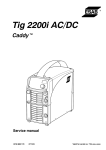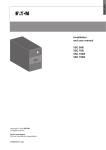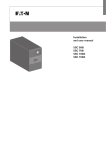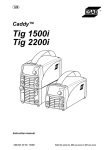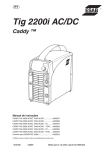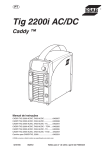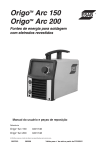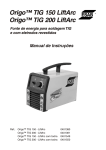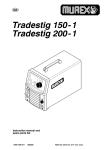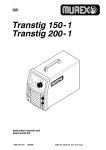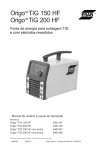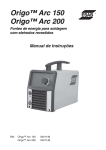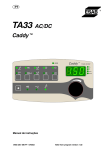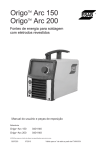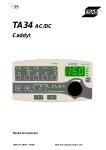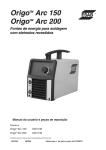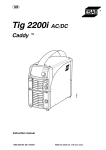Download Tig 1500i TA34 Tig 2200i TA33/TA34
Transcript
Caddyt Tig 1500i TA34 Tig 2200i TA33/TA34 Service manual 0740 800 186 090407 Valid for serial no. 803−xxx−xxxx to 843−xxx−xxxx READ THIS FIRST . . . . . . . . . . . . . . . . . . . . . . . . . . . . . . . . . . . . . . . . . . . . . . . . . . . . . . . . . . . . . . . . . INTRODUCTION . . . . . . . . . . . . . . . . . . . . . . . . . . . . . . . . . . . . . . . . . . . . . . . . . . . . . . . . . . . . . . . . . . . TECHNICAL DATA . . . . . . . . . . . . . . . . . . . . . . . . . . . . . . . . . . . . . . . . . . . . . . . . . . . . . . . . . . . . . . . . . WIRING DIAGRAM . . . . . . . . . . . . . . . . . . . . . . . . . . . . . . . . . . . . . . . . . . . . . . . . . . . . . . . . . . . . . . . . . Component description . . . . . . . . . . . . . . . . . . . . . . . . . . . . . . . . . . . . . . . . . . . . . . . . . . . . . . . . . . Tig 1500i . . . . . . . . . . . . . . . . . . . . . . . . . . . . . . . . . . . . . . . . . . . . . . . . . . . . . . . . . . . . . . . . . . . . . . . . Tig 2200i . . . . . . . . . . . . . . . . . . . . . . . . . . . . . . . . . . . . . . . . . . . . . . . . . . . . . . . . . . . . . . . . . . . . . . . . DESCRIPTION OF OPERATION . . . . . . . . . . . . . . . . . . . . . . . . . . . . . . . . . . . . . . . . . . . . . . . . . . . . . 1 MMC module . . . . . . . . . . . . . . . . . . . . . . . . . . . . . . . . . . . . . . . . . . . . . . . . . . . . . . . . . . . . . . . . . . 2AP1 Power supply board . . . . . . . . . . . . . . . . . . . . . . . . . . . . . . . . . . . . . . . . . . . . . . . . . . . . . . . 2AP1:1 Interference suppressor circuit . . . . . . . . . . . . . . . . . . . . . . . . . . . . . . . . . . . . . . . . . . . . 2AP1:2 Primary circuit . . . . . . . . . . . . . . . . . . . . . . . . . . . . . . . . . . . . . . . . . . . . . . . . . . . . . . . . . . 2AP1:3 Secondary circuit . . . . . . . . . . . . . . . . . . . . . . . . . . . . . . . . . . . . . . . . . . . . . . . . . . . . . . . 2AP1 Component positions . . . . . . . . . . . . . . . . . . . . . . . . . . . . . . . . . . . . . . . . . . . . . . . . . . . . 10AP1 TIG board . . . . . . . . . . . . . . . . . . . . . . . . . . . . . . . . . . . . . . . . . . . . . . . . . . . . . . . . . . . . . . . . 10AP1 Component positions . . . . . . . . . . . . . . . . . . . . . . . . . . . . . . . . . . . . . . . . . . . . . . . . . . . . 15AP1 Power board . . . . . . . . . . . . . . . . . . . . . . . . . . . . . . . . . . . . . . . . . . . . . . . . . . . . . . . . . . . . . Charging circuit . . . . . . . . . . . . . . . . . . . . . . . . . . . . . . . . . . . . . . . . . . . . . . . . . . . . . . . . . . . . . . . . . . Power factor corrector (PFC) . . . . . . . . . . . . . . . . . . . . . . . . . . . . . . . . . . . . . . . . . . . . . . . . . . . . . . . Gate driver stages . . . . . . . . . . . . . . . . . . . . . . . . . . . . . . . . . . . . . . . . . . . . . . . . . . . . . . . . . . . . . . . . Switching circuit . . . . . . . . . . . . . . . . . . . . . . . . . . . . . . . . . . . . . . . . . . . . . . . . . . . . . . . . . . . . . . . . . . Supply to 2AP1 . . . . . . . . . . . . . . . . . . . . . . . . . . . . . . . . . . . . . . . . . . . . . . . . . . . . . . . . . . . . . . . . . . 15AP1 Component positions . . . . . . . . . . . . . . . . . . . . . . . . . . . . . . . . . . . . . . . . . . . . . . . . . . . . 15AP2 Secondary board . . . . . . . . . . . . . . . . . . . . . . . . . . . . . . . . . . . . . . . . . . . . . . . . . . . . . . . . . 15AP2 Component positions . . . . . . . . . . . . . . . . . . . . . . . . . . . . . . . . . . . . . . . . . . . . . . . . . . . . 20AP1 Control board . . . . . . . . . . . . . . . . . . . . . . . . . . . . . . . . . . . . . . . . . . . . . . . . . . . . . . . . . . . . 20AP1:1 Power supply . . . . . . . . . . . . . . . . . . . . . . . . . . . . . . . . . . . . . . . . . . . . . . . . . . . . . . . . . . . 20AP1:2 The CAN bus . . . . . . . . . . . . . . . . . . . . . . . . . . . . . . . . . . . . . . . . . . . . . . . . . . . . . . . . . . . Starting sequence . . . . . . . . . . . . . . . . . . . . . . . . . . . . . . . . . . . . . . . . . . . . . . . . . . . . . . . Communication interruptions . . . . . . . . . . . . . . . . . . . . . . . . . . . . . . . . . . . . . . . . . . . . . Terminating resistors . . . . . . . . . . . . . . . . . . . . . . . . . . . . . . . . . . . . . . . . . . . . . . . . . . . . 20AP1:3 Control panel interface circuits . . . . . . . . . . . . . . . . . . . . . . . . . . . . . . . . . . . . . . . . . . . . 20AP1:4 Pulse width modulator . . . . . . . . . . . . . . . . . . . . . . . . . . . . . . . . . . . . . . . . . . . . . . . . . . . 20AP1:5 Temperature monitoring . . . . . . . . . . . . . . . . . . . . . . . . . . . . . . . . . . . . . . . . . . . . . . . . . . 20AP1:6 Shunt and current control amplifier . . . . . . . . . . . . . . . . . . . . . . . . . . . . . . . . . . . . . . . . 20AP1:7 Arc voltage feedback . . . . . . . . . . . . . . . . . . . . . . . . . . . . . . . . . . . . . . . . . . . . . . . . . . . . 20AP1:8 TIG functions . . . . . . . . . . . . . . . . . . . . . . . . . . . . . . . . . . . . . . . . . . . . . . . . . . . . . . . . . . . 20AP1:9 Welding process control . . . . . . . . . . . . . . . . . . . . . . . . . . . . . . . . . . . . . . . . . . . . . . . . . 20AP1:10 Cooling unit control . . . . . . . . . . . . . . . . . . . . . . . . . . . . . . . . . . . . . . . . . . . . . . . . . . . . . . 20AP1 Component positions . . . . . . . . . . . . . . . . . . . . . . . . . . . . . . . . . . . . . . . . . . . . . . . . . . . . REMOTE CONTROLS . . . . . . . . . . . . . . . . . . . . . . . . . . . . . . . . . . . . . . . . . . . . . . . . . . . . . . . . . . . . . . FAULT CODES . . . . . . . . . . . . . . . . . . . . . . . . . . . . . . . . . . . . . . . . . . . . . . . . . . . . . . . . . . . . . . . . . . . . Fault log . . . . . . . . . . . . . . . . . . . . . . . . . . . . . . . . . . . . . . . . . . . . . . . . . . . . . . . . . . . . . . . . . . . . . . . . Summary of fault codes . . . . . . . . . . . . . . . . . . . . . . . . . . . . . . . . . . . . . . . . . . . . . . . . . . . . . . . . . Fault code description . . . . . . . . . . . . . . . . . . . . . . . . . . . . . . . . . . . . . . . . . . . . . . . . . . . . . . . . . . . Power source . . . . . . . . . . . . . . . . . . . . . . . . . . . . . . . . . . . . . . . . . . . . . . . . . . . . . . . . . . . . . . . . . . . . SERVICE INSTRUCTIONS . . . . . . . . . . . . . . . . . . . . . . . . . . . . . . . . . . . . . . . . . . . . . . . . . . . . . . . . . . What is ESD? . . . . . . . . . . . . . . . . . . . . . . . . . . . . . . . . . . . . . . . . . . . . . . . . . . . . . . . . . . . . . . . . . . . Service aid . . . . . . . . . . . . . . . . . . . . . . . . . . . . . . . . . . . . . . . . . . . . . . . . . . . . . . . . . . . . . . . . . . . . . . Checking the semiconductor module of 15AP1 . . . . . . . . . . . . . . . . . . . . . . . . . . . . . . . . . . . . Checking rectifier and freewheel diodes . . . . . . . . . . . . . . . . . . . . . . . . . . . . . . . . . . . . . . . . . . Checking the gate pulses . . . . . . . . . . . . . . . . . . . . . . . . . . . . . . . . . . . . . . . . . . . . . . . . . . . . . . . . Soft starting . . . . . . . . . . . . . . . . . . . . . . . . . . . . . . . . . . . . . . . . . . . . . . . . . . . . . . . . . . . . . . . . . . . . Mounting components on the heat sink . . . . . . . . . . . . . . . . . . . . . . . . . . . . . . . . . . . . . . . . . . . 4 4 5 6 6 8 10 12 12 13 13 14 15 16 18 19 20 20 20 21 21 21 22 23 23 24 24 26 26 26 27 27 27 28 28 29 29 30 31 32 33 33 33 33 34 34 36 36 36 38 40 41 42 44 Rights reserved to alter specifications without notice. TOCe −2− S0740 800 186/E090407/P50 INSTRUCTIONS . . . . . . . . . . . . . . . . . . . . . . . . . . . . . . . . . . . . . . . . . . . . . . . . . . . . . . . . . . . . . . . . . . . SAFETY . . . . . . . . . . . . . . . . . . . . . . . . . . . . . . . . . . . . . . . . . . . . . . . . . . . . . . . . . . . . . . . . . . . . . . . . INSTALLATION . . . . . . . . . . . . . . . . . . . . . . . . . . . . . . . . . . . . . . . . . . . . . . . . . . . . . . . . . . . . . . . . . . Location . . . . . . . . . . . . . . . . . . . . . . . . . . . . . . . . . . . . . . . . . . . . . . . . . . . . . . . . . . . . . . . . . . . . . . . . Mains power supply . . . . . . . . . . . . . . . . . . . . . . . . . . . . . . . . . . . . . . . . . . . . . . . . . . . . . . . . . . . . . OPERATION . . . . . . . . . . . . . . . . . . . . . . . . . . . . . . . . . . . . . . . . . . . . . . . . . . . . . . . . . . . . . . . . . . . . Connections and control devices . . . . . . . . . . . . . . . . . . . . . . . . . . . . . . . . . . . . . . . . . . . . . . . . . Water connection . . . . . . . . . . . . . . . . . . . . . . . . . . . . . . . . . . . . . . . . . . . . . . . . . . . . . . . . . . . . . . . Overheating protection . . . . . . . . . . . . . . . . . . . . . . . . . . . . . . . . . . . . . . . . . . . . . . . . . . . . . . . . . . MAINTENANCE . . . . . . . . . . . . . . . . . . . . . . . . . . . . . . . . . . . . . . . . . . . . . . . . . . . . . . . . . . . . . . . . . Inspection and cleaning . . . . . . . . . . . . . . . . . . . . . . . . . . . . . . . . . . . . . . . . . . . . . . . . . . . . . . . . . FAULT−TRACING . . . . . . . . . . . . . . . . . . . . . . . . . . . . . . . . . . . . . . . . . . . . . . . . . . . . . . . . . . . . . . . . SPARE PARTS . . . . . . . . . . . . . . . . . . . . . . . . . . . . . . . . . . . . . . . . . . . . . . . . . . . . . . . . . . . . . . . . . . . . NOTES . . . . . . . . . . . . . . . . . . . . . . . . . . . . . . . . . . . . . . . . . . . . . . . . . . . . . . . . . . . . . . . . . . . . . . . . . . . 45 45 45 45 45 46 46 47 47 47 47 48 48 49 Rights reserved to alter specifications without notice. TOCe −3− S0740 800 186/E090407/P50 READ THIS FIRST Maintenance and repair work should be performed by an experienced person, and electrical work only by a trained electrician. Use only recommended replacement parts. This service manual is intended for use by technicians with electrical/electronic training for help in connection with fault−tracing and repair. Use the wiring diagram as a form of index for the description of operation. The circuit boards are divided into numbered blocks, which are described individually in more detail in the description of operation. Component names in the wiring diagram are listed in the component description. Use the spare parts list as a guide to where the components are located in the equipment. The spare parts list is published as a separate document, see page 48. This manual contains details of design changes that have been made up to and including March 2009. The manual is valid for: Tig 1500i TA34 and Tig 2200i TA33/TA34 with serial no. 803−xxx−xxxx, 828−xxx−xxxx, and 843−xxx−xxxx. The Tig 1500i and Tig 2200i are designed and tested in accordance with international and European standards IEC/EN 60974. On completion of service or repair work, it is the responsibility of the person(s) performing the work to ensure that the product still complies with the requirements of the above standard. INTRODUCTION Design structure of the power source Block diagram of the Tig 1500i and Tig 2200i The power source is transistor−controlled, operating on the inverter principle. It consists of a number of function modules, as shown in the block diagram above. Each module has a ct34_00 −4− S0740 800 186/E090407/P50 module number, which is always included as the first part of the name/identification of components in the module. The modules have the following main functions: 1 MMC module Control panel and display board. 2 Mains module Mains switch, mains interference suppressor and power supply board. 10 TIG module Torch switch interface, HF unit, gas valve. 15 Power module This module is a single forward converter, operating at a switching frequency of 65 kHz. All power semiconductors are built into modules. 20 Processor board module (controller module) This is the controller board, 20AP1, that monitors and controls the power source. The micro processor of the board comprises the welding data unit. TECHNICAL DATA Tig 1500i TA34 Tig 2200i TA33/TA34 230V $10%, 1∼ 50/60 Hz Mains voltage Primary current Imax TIG Imax MMA 13.8 A 21.3 A 24.9 A 24.1 A Mains supply Zmax 0.35 ohm Zmax 0.30 ohm No−load power 30 W 30 W 3 − 150 A 4 − 150 A 3 − 220 A 4 − 170 A Permissible load at TIG 20% duty cycle 25% duty cycle 60% duty cycle 100% duty cycle − 150 A / 16 V 120 A / 14.8 V 110 A / 14.4 V 220 A / 18.8 V − 150 A / 16.0 V 110 A / 14.4 V Permissible load at MMA 25% duty cycle 60% duty cycle 100% duty cycle 150 A / 26 V 100 A / 24 V 90 A / 23.6 V 170 A / 26.8 V 130 A / 25.2 V 110 A / 24.4 V Power factor at maximum current TIG MMA 0.99 0.99 0.99 0.99 Efficiency at maximum current TIG MMA 76 % 80 % 75 % 81 % Open−circuit voltage without VRD function with VRD function See page 29 < 35 V See page 29 < 35 V Operating temperature −10 to + 40°C −10 to + 40°C Transportation temperature −20 to + 55°C −20 to + 55°C Constant sound pressure in open−circuit < 70 dB (A) < 70 dB (A) Dimensions, l x b x h without water cooler with water cooler 418 x 188 x 208 mm 418 x 188 x 208 mm 418 x 188 x 345 mm Setting range ct34_00 TIG MMA −5− S0740 800 186/E090407/P50 Tig 1500i TA34 Tig 2200i TA33/TA34 Weight without cooling unit cooling unit with / without cooling water 9.2 kg 9.4 kg 6.7 kg / 4.5 kg Shielding gas max pressure All types intended for TIG welding 5 bar All types intended for TIG welding 5 bar Insulation class transformer H H Enclosure class Application class IP 23 IP 23 Duty cycle The duty cycle refers to the time as a percentage of a ten−minute period that you can weld at a certain load without overloading. The duty cycle is valid for 40°C. The duty cycle is valid for 40°C ambient temperature. Enclosure class The IP code indicates the enclosure class, i. e. the degree of protection against penetration by solid objects or water. Equipment marked IP23 is designed for indoor and outdoor use. Application class The symbol indicates that the power source is designed for use in areas with increased electrical hazard. WIRING DIAGRAM The power source is based on a number of function modules. These are described in the component descriptions on the following pages. Wire numbers and component names in the wiring diagram show to which module each component belongs. Circuit boards within each module have names such as 15AP1 − 15AP99. 15 = module association, 1−69 AP = circuit board 1 = individual identification number, 0−99 Components within modules are named in a similar way. Component description 1 MMC module: control panel and display board, see page 12. 2 Mains module. 2AP1 Power supply board, see page 13. 2L1−2L8 Ferrite ring cores. 2QF1 Mains switch. 2XS1 Flat pin sockets. Important: to obtain a proper electric connection, the complete cord set must be replaced if the sockets have to be replaced. 10 TIG module. 10AP1 TIG board, see page 18. ct34_00 −6− S0740 800 186/E090407/P50 10TV1 HF transformer. 10YV1 Gas valve, 230 V AC. 15 Power module. 15AP1 Power board, see page 20. 15AP2 Secondary board, see page 23. 15C1 Smoothing capacitor, 1000 uF. 15D1 Diode module with rectifier and freewheel diodes. 15EV1 Fan. 15L1 Inductor. 15L2 PFC Inductor (Power Factor Corrector) 15RS1 Shunt. 60 mV at 100 A. 15ST1 Thermal switch, fitted in the winding of main transformer 15TM1. See page 28. 15ST2 Thermal switch, fitted on the heat sink. See page 28. 15TM1 Main transformer. 20AP1 Controller circuit board. See the description on page 24. 20L1 Ferrite ring core. CAUTION ! STATIC ELECTRICITY can damage circuit boards and electronic components. ESD S Observe precautions for handling electrostatic− sensitive devices. S Use proper static−proof bags and boxes. Placement of the circuit boards ct34_00 −7− S0740 800 186/E090407/P50 Tig 1500i with control panel TA34 ct34_00 −8− S0740 800 186/E090407/P50 ct34_00 −9− S0740 800 186/E090407/P50 Tig 2200i with control panels TA33 and TA34 ct34_00 − 10 − S0740 800 186/E090407/P50 ct34_00 − 11 − S0740 800 186/E090407/P50 DESCRIPTION OF OPERATION This description of operation describes the function of circuit boards and other components in the equipment. It is divided into sections, numbered to correspond to the circuit board numbers and divisions into function blocks. 1 MMC module The MMC module consists of an operator’s control panel and a display board. The control panel is used for setting and displaying welding data. The welding data are stored by the control board of the power source. The control panels are described in separate instruction and service manuals. TA33 intended for MMA− and DC TIG welding without pulsing. TA34 intended for MMA− and DC TIG welding with pulsing. S TA33 S TA34 Pushbuttons are used for parameter selection and a knob for parameter settings, current, time etc. ct34_01 − 12 − S0740 800 186/E090407/P50 2AP1 Power supply board The power supply board filters the mains voltage and generates internal supply voltages for the machine. There are two versions of the power supply board: 0487 064−884 is used for the Tig 1500i and 0487 631−880 is used for the Tig 2200i. The difference between the two versions is the size of inductor L1. Circuit board 0487 631−880 is deliverd as spare part for all machines. 2AP1:1 Interference suppressor circuit WARNING! Dangerous voltage − mains voltage. The mains voltage is filtered by the power supply board. Power board 15AP1 rectifies the mains voltage. TIG board 10AP1 uses the mains voltage for supply to the HF generator and the gas valve. ct34_02 − 13 − S0740 800 186/E090407/P50 2AP1:2 Primary circuit WARNING! Dangerous voltage − mains voltage. The primary circuit is supplied with 325 V DC from the power board, 15AP1. S1 is a fuse with high rupturing capacity. Transistor Q5 is the switching element in a switched voltage supply. The secondary voltage, +24 V, is sensed by IC2 and controlled by IC1. The isolation voltage of transformer T1 and optocoupler IC3 is 4 kV. +15V A Internal power supply to 2AP1 and power supply to the PFC circuits of the power board, 15AP1. The voltage is controlled by VR1, it has a tolerance of $0.75V. ct34_02 − 14 − S0740 800 186/E090407/P50 2AP1:3 Secondary circuit The secondary circuit delivers the following voltages: +24 V The voltage is controlled by IC1 on the primary side. It has a tolerance of $0.6 V. +5 V The voltage is controlled by VR3. It has a tolerance of $0.25 V. −15 V The voltage is controlled by VR2. It has a tolerance of $0.75 V. +13 VB (+12V CAN) This voltage is unregulated. It has a tolerance of $1.5 V. Early warning power shut down If the voltage goes low, output PS4 generates a warning signal to the processor on circuit board 20AP1 (see page 24). Transistor Q6 switches off the fan, 15EV1, at the same time. ct34_02 − 15 − S0740 800 186/E090407/P50 2AP1 Component positions Power supply board 0487 064−884, used for the Tig 1500i WARNING! Dangerous voltage − mains voltage. ct34_02 − 16 − S0740 800 186/E090407/P50 Power supply board 0487 631−880, used for the Tig 2200i and as spare part WARNING! Dangerous voltage − mains voltage. ct34_02 − 17 − S0740 800 186/E090407/P50 10AP1 TIG board WARNING! Dangerous voltage − mains voltage. The relay contacts, the gas valve 10YV1, the HF generator TR2 and the primary side of transformer TR1 are connected to 230 V mains voltage. The processor on circuit board 20AP1 controls the HF generator and gas valve. HF generator When the welding torch switch is operated, and the open−circuit voltage is over 50 V, relay RE2 closes and turns on the HF generator, TR2. It remains activated until the arc strikes, or for a maximum of 0.5 seconds. The voltage on the primary side of HF transformer 10TV1 is about 550 V. The secondary voltage is about 11 kV if a 4 metre long welding torch is connected. If the welding torch is 16 metre long, the HF spark is about 8 kV. Due to electromagnetic interference regulations, the energy in the HF ignition spark is limited, and so the HF spark weakens with increasing length of the torch. The HF ignition is satisfactory for welding torches up to 16 metres. Gas valve When the torch switch is operated, relay RE1 closes and energizes the gas valve. When the torch switch is released and the gas post−flow time has elapsed, the gas valve is deactivated. TIG torch switch The secondary windings of transformer TR1 and rectifier bridge D3−D6 produce 24 V DC. This voltage energizes relay RE3 when the torch switch is closed. ct33_10 − 18 − S0740 800 186/E090407/P50 10AP1 Component positions WARNING! Dangerous voltage − mains voltage. ct33_10 − 19 − S0740 800 186/E090407/P50 15AP1 Power board WARNING! Dangerous voltage − mains voltage. Never make any measurements on this board when the machine is connected to the mains supply. CAUTION! There are different versions of the power board available. See the spare parts list to find the correct spare part for the machine. The power module is a single forward converter, operating at a switching frequency of 65 kHz. The switch transistors are built into a semiconductor module, PM1. See pages 38 to 40 and 41 to 43 for measurement instructions. If the power board has failed, a replacement board must be mounted in accordance with the instructions on page 44. The power board carries the mains rectifier, the charging circuit, the PFC circuit, the gate circuits and the switching circuits. The mains rectifier, the switching transistors and parts of the charge and PFC circuits are integrated in a semiconductor module, PM1, which is part of the power board. Charging circuit When the mains power supply is turned on, the rectified mains voltage charges smoothing capacitor 15C1 via resistor R31. Thyristor TY1 short−circuits charge resistor R31 when the machine is loaded. If TY1 did not conduct, resistor R31 would burn out when the unit is on load. Power factor corrector (PFC) The aim with the power factor corrector is to keep the mains current sinusoidal and in phase with the mains voltage. The PFC circuit holds the intermediate voltage at 365 V. At mains currents above 26 A the PFC does not work, the intermediate voltage is then 325 V or less. When the PFC is working properly the voltage across capacitor 15C1 is 365 V. ct33_15_1 − 20 − S0740 800 186/E090407/P50 Gate driver stages Transformer TR1 is a gate driver transformer for galvanic isolation of the drive circuits from controller board 20AP1. Switching circuit The switching transistors are integrated in the semiconductor module, PM1. Supply to 2AP1 The board supplies power supply board 2AP1 with 325 V DC (pins F1 and F3, connector 15XS1). ct33_15_1 − 21 − S0740 800 186/E090407/P50 15AP1 Component positions Pin positions of the semiconductor module: (Seen from the component side of the board). Pin 1 marked P1 starts in the down−left corner and continuous anticlockwise around the semiconductor module. ct33_15_1 − 22 − S0740 800 186/E090407/P50 15AP2 Secondary board The secondary board is fitted on the main transformer 15TM1, diode module 15D1 and inductor 15L1. Diode module 15D1 comprises two diodes, rectifier and freewheel diode. During the time interval between two voltage pulses from transformer 15TM1, the freewheel diode maintain the welding current from inductor 15L1. If the diode module has failed, a replacement module must be fitted in accordance with the instructions on page 44. Inductor L1 forms an LC circuit with C3//C4 and D1 to reduce the risk of arc extinction at low welding currents. When rectifier diode 15D1 conducts, the LC circuit charges up. The circuit is capable of temporarily maintaining a high arc voltage at low current, thus reducing the risk of arc extinction. Diode D1 prevents capacitor C3//C4 from going negative. 15AP2 ch31_15_2 Component positions − 23 − S0740 800 186/E090407/P50 20AP1 Control board The processor on the control board monitors and controls the various functions of the power source. The control board is used in combi mode. In combi mode the board handles the control of the power source, the welding data unit and the MMC panel. If the circuit board is faulty, it must be replaced. After replacing the circuit board, soft−start the power source. See the instructions on page 42. There are two hardware versions of the control board, see page 32. Note! The spare part boards have different ordering numbers for the Tig 1500i TA34, Tig 2200i TA33 and Tig 2200i TA34, see the spare parts list. Circuit board identity Power source unit The control board has a machine ID, a hardware ID and a unit type number. To read this you need the ESAT service kit, see page 37. S S S The machine ID defines which type of power source the board is intended for. The hardware ID shows design and type of circuit board. The unit type is used for identification on the CAN bus. The ID numbers of the power sources are: Tig 1500i Machine ID = 35 Hardware ID = 4 Unit type = 2 Tig 2200i Machine ID = 36 Hardware ID = 4 Unit type = 2 Welding data unit and MMC The machine ID for the MMC part of the control board determines which type of control panel that is used. The machine ID can be changed by ESAT. The ID numbers of the different control panels are: TA33 machine ID = 37 TA34 machine ID = 19 Hardware ID = 4 Unit type = 0 20AP1:1 Power supply +5 V and +2.5 V IC6 monitors the 24 V voltage supply to the 5 V regulator on circuit board 2AP1. IC16 monitors the 5 and 2.5 V supplies. Regulator VR4 supplies the processor with +2.5 V. ct34_20 − 24 − S0740 800 186/E090407/P50 The voltage on terminal PS4 is normally about 24 V, when this drops below 20 V, pin 14 of IC6 goes low, providing the processor with a low power supply voltage signal. The processor then stores current data and generates fault code E4. When the 5 and 2.5 V voltages are passing below their treshold values, the processor receives a reset signal from IC16. Fault code E4 is not displayed at normal power off +15 V and +20 V Voltage regulator VR2 produces an output voltage of +20 $1.0 V, which supplies the pulse width modulator output stage. Voltage divider R70/R75 supplies 2.6 V to the processor. This provides a signal that the power supply is available. Voltage regulator VR1 produces an output voltage of +15 V, and this, together with the −15 V supply, powers the analogue circuits. −15 V The −15 V power supply is monitored by the processor. +12 V_CAN The +13 VB from 2AP1 is used to supply the CAN circuits of the equipment. This supply is referred to as + 12 V_CAN, its neutral point, 0 V_CAN, is separated from the electronic neutral (0 V). The tolerance of the voltage is 11.5 to 14.5 V. ct34_20 − 25 − S0740 800 186/E090407/P50 20AP1:2 The CAN bus Bus communication circuits to and from the control board A standardised communication (CAN − Controller Area Network) bus is used for communication between the units of the equipment. Communication speed is 400 kbit/s. The +12V_CAN and 0V_CAN power supply is unregulated and is galvanically isolated from other parts of the control board. The shell of the CAN−connectors and the shield of the CAN cables are connected to 0V_CAN. GND in the diagram is connected to the power source chassis. Voltage regulator VR5 supplies a 5 V power supply to the CAN circuits on 20AP1. Starting sequence On power−up, the board’s CAN controller reads in the bus speed from the micro processor: 400 kbit/s. The circuit board displays the starting sequence from power−up. LED1 lights red. Then LED1, LED2 and LED3 lights green. When the board has been initiated, and the power source is in the application program, LED1 flashes continously with a green light. LEDs on circuit board 20AP1 Communication interruptions If the CAN bus fails, the control panel will normally generate a fault message. Check the following points in the event of problems with CAN communications: S ct34_20 The terminating resistor. The CAN bus resistance must lie in the range 50−130 ohm: the optimum value is 60 ohm. To check the resistance, turn off the power source and measure the resistance between pins L and K in connector socket XS25. − 26 − S0740 800 186/E090407/P50 S All screen connections must be sound. Check the screen connections of the CAN cabling. S Good contact with the chassis connections from/to the circuit boards and suppressor capacitors. See the main circuit diagram. S The connection cable between units. Check that the correct type of cable is being used. Check that each signal is being carried by the correct core. CAN H and CAN L must be carried by the twinned pair. Terminating resistors In order to avoid communication interference, the ends of the CAN bus must be terminated by resistive loads. Principle diagram of the CAN bus and connecting up of the terminating resistors 20AP1:3 Control panel interface circuits See the service manual for the TA33 and TA34 control panels, filename: 0740 800 180. 20AP1:4 Pulse width modulator The pulse width modulator determines the frequency and pulse time of the switching transistors’ control pulses. IC3 controls the pulse frequency, the pulse time and inhibition of pulses. The pulse frequency is 65 kHz +/− 1kHz, with a maximum pulse width of 43 − 44 % of the cycle width. See page 41 for screen traces of waveforms and measurement instructions. Transistor Q5 controls the primary winding of the pulse transformer on circuit board 15AP1. ct34_20 − 27 − S0740 800 186/E090407/P50 20AP1:5 Temperature monitoring The thermal overload switches, 15ST1 and 15ST2, are normally closed. Terminal T2 of the circuit board is at 0 V. 15ST2, which is fitted on the heat sink, opens at 75 _C. 15ST1, which is fitted in the winding of the main transformer, 15TM1, opens at 130 _C. If either of the switches operates, the power source is stopped, fault code E06 is displayed. The power source cannot be restarted until it has cooled sufficiently for the switch(es) to reclose. 20AP1:6 Shunt and current control amplifier The shunt produces 60 mV at a welding current of 100 A. The shunt response is linear to the welding current. If the shunt is not connected to the circuit board, resistor R2 supplies about 1.4 to 1.9 V to the shunt input. This blocks the current control amplifier, i.e. the power source does not deliver any welding current. ct34_20 − 28 − S0740 800 186/E090407/P50 20AP1:7 Arc voltage feedback This circuit measures and scales the arc voltage to a suitable level for the processor. 64 V arc voltage produces a voltage signal of 5.0 V at the cathode of diode D13. Open−circuit voltage control Version 1 of 20AP1: The open−circuit voltage control holds the voltage at about 70 V. Version 2 of 20AP1: The open−circuit voltage control holds the voltage at 46 − 60 V. When the VRD (voltage−reducing device) function is active, the open−circuit voltage is < 35 V (19 − 26 V). The VRD function can only be activated or deactivated by the ESAT, see page 37. Note! Spare part boards are delivered with the VRD function deactivated. See the component positions diagram on page 32 for identification of circuit board versions. TIG The open−circuit voltage is about 90 V. Arc voltages above 45 V are defined as no welding. Output voltage is produced only when TIG welding is in progress. If the open−circuit voltage/arc voltage is above 45 V for more than 100 milliseconds the open−circuit voltage control is activated and then the output voltage is shut down. MMA S The power source generates the actual open−circuit voltage, see: “Open−circuit voltage control” above. S Touch the electrode on to the workpiece. When the open−circuit voltage goes below 45 V (16 V when VRD is active), the open−circuit voltage control is disabled. S When the current exceeds 8 A the hot start current is activated. S When the arc voltage exceeds 52 V, welding stops and the open−circuit voltage control is activated. 20AP1:8 TIG functions LiftArc TIG start S Touch the electrode on to the workpiece. S Press the torch trigger. The power source produces a current of about 6 A. S Lift the electrode from the workpiece. The arc strikes and the current increases to 30 A. S When the arc voltage exceeds 8 V, the current increases / decreases to the set current. ct34_20 − 29 − S0740 800 186/E090407/P50 HF TIG start See: 10AP1 TIG board, on page 18. 20AP1:9 Welding process control The processor inputs are the set values of welding data and the arc voltage. The processor also calculates a set value signal for welding current, and supplies this to the current control amplifier. The process regulator control principle Current Hot start MMA Peak current Adjustable starting current Set current 1 2 Starting current, MMA welding mode 1. Phase 1, fixed starting current depending on the set current. 2. Phase 2, hot start = adjustable starting current. Time MMA normal welding mode In the MMA normal welding mode, the welding current is briefly increased at the start of welding. The peak current, phase 1 in the diagram above, is engaged for 150 milliseconds. The peak current is twice the normal welding current up to 150 A (i.e. twice the set value), subject to a maximum of 210 A for the Tig 1500i and 240 A for the Tig 2200i. The hot start current, phase 2 above, is engaged for 1.5 seconds. It is set in per cent of the set current, but does never exceed the peak current. MMA drop welding mode In the MMA drop welding mode, the peak current is three times the set value, but the duration is shorter at only 50 ms. The hot start current, phase 2 above, is engaged for 240 milliseconds. It is set in per cent of the set current, but does never exceed the peak current. ct34_20 − 30 − S0740 800 186/E090407/P50 20AP1:10 Cooling unit control Starting the welding equipment 1. 2. 3. The welding data unit senses whether the water lock microswitch, 5S2, is closed or not. If it is closed, a command to start the pump is generated, and a relay in the cooler starts the pump and the fan. If welding does not start within 6.5 minutes, the pump is stopped. The pump is stopped if the water lock microswitch opens. Starting to weld 1. 2. 3. The welder presses the welding torch trigger switch. The water pump starts if the water lock microswitch is closed. Welding starts. Stopping welding 1. 2. 3. The welder releases the trigger switch. Welding stops. The water pump continues to run for a further 6.5 minutes. If welding is restarted while the pump is still running, the pump will continue to run as required, i.e. the 6.5 minute shutdown countdown is interrupted. Flow guard can not be installed in the CoolMini. The flow guard input is jumpered with wire 541 in the cooler, the behaviour is as if the cooling water is always flowing. Microswitch 5S2 in the water lock connector closes when a cooling water hose is connected to the blue water connector on the front of the cooling unit. The pump stops if the switch opens. ct34_20 − 31 − S0740 800 186/E090407/P50 20AP1 Component positions Version 2 of the control board There are two hardware versions of the control board. See page 29 for description of the differnce in function between the two versions. The print number of the circuit board is used to identify the hardware version of the board. The print number is to the right in the component positions diagram above. (The print number is NOT the same as the ordering number of the board.) Version 1 of 20AP1: Print numbers up to and including 487343−004. Power sources with serial no. 803−xxx−xxxx are delivered with version 1 of 20AP1. Version 2 of 20AP1: Print numbers from 487343−005 and there above. Power sources with serial no. 828−xxx−xxxx and 843−xxx−xxxx are delivered with version 2 of 20AP1. Spare parts: Version 2 of 20AP1 is delivered as spare part to all power sources. ct34_20 − 32 − S0740 800 186/E090407/P50 REMOTE CONTROLS A number of remote control units can be connected to the power source, these are described in a separate service manual with filename 0740 800 170. FAULT CODES Fault codes are used in order to indicate and identify a fault in the equipment. Fault log All faults that occur when using the welding equipment are documented as error messages in the fault log. When the fault log is full, the oldest message will automatically erase when the next fault occurs. Only the most recent fault message is displayed on the control panel. To read the entire fault log, the machine must be connected to the ESAT: see service tools on page 37. Faults are monitored/detected in two ways: by test routines that are run on initiation and by functions that can detect a fault when it occurs. The control panel displays a unit number to indicate which unit has generated the fault. The following unit numbers are used: U0 = welding data unit U2 = power source U4 = remote control unit Summary of fault codes Code Description Welding data unit Power source Remote control unit *1 Memory error, EPROM x x x *2 Memory error, RAM x x *3 Memory error, external RAM x x 4 +5 V power supply x 6 High temperature x *8 Power supply 1 x *9 Power supply 2 x 12 Communication error (warning) x *14 Communication error (bus off) x x x x x 15 Lost messages x 16 High open−circuit voltage (VRD) x *18 Lost contact with the power source x *19 Memory error in data memory x *22 Transmitter buffer overflow x x *23 Receiver buffer overflow x x *26 Program operating fault x ct34f1 − 33 − S0740 800 186/E090407/P50 Code Description Welding data unit Power source *28 Stack overflow x x *40 Incompatible units x Remote control unit Fault codes marked with an asterisk ( * ) are not displayed by the control panel. but they are stored in the fault log. To get access to the fault log use the ESAT service tool. See page 37. Fault code description This manual describes the fault codes for the power source. The fault codes for the other units are described in the manuals for these units. Note! The welding data unit is operated by the processor of the control board in the power source. The fault codes for the welding data unit are described in the service manual for the control panel. Power source Code Description, power source 1 EPROM check sum error − program memory error Check sum test of the program memory, which is run only when initiating the power source after power−up. This fault does not disable any functions. The program memory is damaged. This is a serious fault, that can have unforeseen effects. Action: Restart the machine. If the fault persists, load new software via ESAT. If the fault still persists, replace circuit board 20AP1, which carries the memory chip. 2 Microprocessor RAM error The microprocessor is unable to read/write from/to a particular memory address in its internal memory. This test is preformed only on initiation after power−up. This fault does not disable any functions. Action: Restart the machine. If the fault persists, replace circuit board 20AP1, which carries the microprocessor chip. 3 Error in external RAM Read/write test of the processor’s internal external RAM. This test is preformed only as part of initiation after power−up. The microprocessor is unable to read/write from/to a particular memory address in its external memory. This fault does not disable any functions. Action: Restart the machine. If the fault persists, replace circuit board 20AP1, which carries the microprocessor chip. 4 5 V power supply too low The unregulated power supply voltage (+24 V) is too low: the smoothing capacitors cannot keep the voltage up enough for the processor to continue to operate. The processor stops all normal activities, expecting to be shut down. Action: Turn off the mains power supply to reset the unit. If the fault persists, check the power supply to circuit board 20AP1. ct34f1 − 34 − S0740 800 186/E090407/P50 Code Description, power source 6 High temperature The temperature monitoring circuit has operated. The power source is stopped, and cannot be restarted until the circuit has reset. See also page 28. Possible causes: Overloading, fan not working properly, cooling air inlets or outlets blocked or obstructed or dirt on the heat exchanger. 12 Communication error (warning) The load on the system CAN bus is temporarily too high, or there is electric noise on the bus. Action: See section 20AP1:2 ’The CAN bus’ on pages 26 to 27. 15 Lost messages The bus CAN controller indicates that a message has been lost. No functions are disabled by this fault. Action: Check that all units are correct connected to the CAN bus. See also section 20AP1:2 ’The CAN bus’ on pages 26 to 27. 16 High open−circuit voltage (VRD) The open−circuit voltage has been too high. Action: Turn off the mains power supply to reset the unit. If the fault persists, check the arc voltage feedback: see page 29. 22 Transmitter buffer overflow The control board is unable to transmit information to the other units at a sufficiently high speed. Action: A break in the bus line can cause this fault. Check the CAN cabling. Turn off the mains power supply to reset the unit. 23 Receiver buffer overflow The control board is unable to process information from the other units at a sufficiently high speed. This fault is caused by abnormal loading of the microprocessor. Action: Turn off the mains power supply to reset the unit. ct34f1 − 35 − S0740 800 186/E090407/P50 SERVICE INSTRUCTIONS CAUTION ! STATIC ELECTRICITY can damage circuit boards and electronic components. ESD S Observe precautions for handling electrostatic− sensitive devices. S Use proper static−proof bags and boxes. What is ESD? A sudden transfer or discharge of static electricity from one object to another. ESD stands for Electrostatic Discharge. How does ESD damage occur? ESD can cause damage to sensitive electrical components, but is not dangerous to people. ESD damage occurs when an ungrounded person or object with a static charge comes into contact with a component or assembly that is grounded. A rapid discharge can occur, causing damage. This damage can take the form of immediate failure, but it is more likely that system performance will be affected and the component will fail prematurely. How do we prevent ESD damage? ESD damage can be prevented by awareness. If static electricity is prevented from building up on you or on anything at your work station, then there cannot be any static discharges. Nonconductive materials (e.g. fabrics), or insulators (e.g. plastics) generate and hold static charge, so you should not bring unnecessary nonconductive items into the work area. It is obviously difficult to avoid all such items, so various means are used to drain off any static discharge from persons to prevent the risk of ESD damage. This is done by simple devices: wrist straps, connected to ground, and conductive shoes. Work surfaces, carts and containers must be conductive and grounded. Use only antistatic packaging materials. Overall, handling of ESD−sensitive devices should be minimized to prevent damage. Service aid We can offer a number of service tools that will simplify the service. Soft−starting tool SST 3 The soft−starting tool SST 3 is made for ESAB’s single phase inverters and for 3−phase inverters with 250 A output current. Ordering no. 0459 534 881. The SST 3 is replacing the SST 1, which only can be used for the single phase inverters. The tool includes: Soft starting rectifier, cable set, voltage test board, gate pulse load and shunt voltage resistor for single phase inverters with analogue control board (Arc 151i A31, Arc 152i A31 and OrigoArc). For the 3−phase machines there are: soft−starting−voltage adapter with current limit and temperature−switch jumper. cp02f2 − 36 − S0740 800 186/E090407/P50 Antistatic service kit Ordering no. 0740 511 001 The kit makes it easier to protect sensitve components from electrostatic discharge. Contents: S A conductive mat (size 610 x 610 mm) S A 1.5 metre long ground cable with a crocodile clip S An adjustable wrist strap and cable with an inbuilt protective resistor Antistatic service kit ESAT service kit The software update is made from a PC, it has to be managed by a trained serviceman. For this a PC program called ESAT, ESAB Software Administration Tool, is needed. The PC is connected to the welding equipment by a cable connector and a CAN reader. From the ESAT it is possible to update the software. ESAT also contains service functions by which it is possible to control, change or read the different functions of the equipment. For the installation and use of the ESAT you need a PC with operating system Windows. The ESAT service kit contents: S CAN adapter with connection cables S CD with software S Instruction manual for ESAT Ordering no: 0458 847 880 0458 847 881 cp02f2 PPCAN for connection to the print port of the PC USB2CAN for connection to the USB port of the PC − 37 − S0740 800 186/E090407/P50 Checking the semiconductor module of 15AP1 Measuring points for the semiconductor module, PM1 Disconnect the machine from the mains and follow the instructions below. Measurements 2 − 6: Use a multimeter in diode test position to measure the diodes. Measure with the positive and negative of the multimeter connected as shown in the picture above. The main transformer must be connected to terminals T1 and T2. 1. Resistor R31 (and thyristor TY1 in parallel): measure the resistance of R31. It must be 12 ohm (on some boards the resistance of R31 is 6.8 or 10 ohm, which are also approved values). 2. PM1, diode P1D: measure between resistor R31 and terminal N1. PM1, diode P2D: measure between resistor R31 and terminal N2. The forward voltage drop must be 0.4 to 0.6 V. 3. PM1, diode N1D: measure between the negative of capacitor 15C1 and terminal N1. PM1, diode N2D: measure between the negative of capacitor 15C1 and terminal N2. The forward voltage drop must be 0.4 to 0.6 V. 4. PM1, diode D2: measure between the negative of capacitor 15C1 and terminal T2. The forward voltage drop must be 0.3 to 0.5 V. ct33f3semi − 38 − S0740 800 186/E090407/P50 5. PM1, diode D3: measure between the positive of capacitor 15C1 and terminal T2. The forward voltage drop must be 0.3 to 0.5 V. 6. PM1, diode D1: measure between the positive of capacitor 15C1 and terminal L2. The forward voltage drop must be 0.3 to 0.5 V. 7. PM1, transistor Q2: measure the resistance between source, the positive of capacitor 15C1, and gate, pin 19 of the module. The resistance must be higher than 500 kohm. 8. PM1, transistor Q3: measure the resistance between source, terminal T2, and gate, pin 14 of the module. The resistance must be higher than 500 kohm. Circuit diagram and measuring points for the semiconductor module ct33f3semi − 39 − S0740 800 186/E090407/P50 Checking rectifier and freewheel diodes 1. Disconnect the machine from the mains. 2. Dismantle the housing of the machine. 3. Use a Torx key no. T25 to unscrew and remove five screws from circuit board 15AP2. The screws are marked on the picture below, 4. Bend out the circuit board so that it has no contact with the connections of the diode module. 5. Use a multimeter in diode test position to measure the forward voltage drop of the two diodes: see the picture below. The voltage drop must be 0.3 to 0.5 V. 6. If the diode module has to be replaced, follow the instructions on page 44. Measuring points, circuit board 15AP2 Circuit diagram and measuring points, circuit board 15AP2 ch31f3diode − 40 − S0740 800 186/E090407/P50 Checking the gate pulses When checking the gate pulses, the machine can either be in soft−start mode or in normal operation mode. Special equipment To measure the gate pulses, you need a gate pulse load. This is included in soft−starting tool SST 3, which is described on page 36. Instructions 1. Disconnect the machine from the mains. 2. Disconnect connector 20XS5 from terminal G on control board 20AP1. 3. Connect the gate pulse test cable of the SST 3 to terminal G on control board 20AP1. Measuring connection for the gate pulses 4. Switch on the machine. 5. Connect an oscilloscope to the SST 3, with the probe to terminal G2 and the screen to terminal G1 of SST 3. 6. Set the machine to MMA welding mode. 7. Measure the pulse frequency. It must be 65 kHz +/− 1kHz. 8. Measure the duration of the negative pulse. It must be 41 − 43 % of the cycle time, measured at a voltage level of −10 V. 9. The waveform of the pulses must be as shown below. Gate pulses from circuit board 20AP1 ct33f3gate − 41 − S0740 800 186/E090407/P50 Soft starting We recommend soft starting of the machine after replacing control circuit board 20AP1, power supply board 2AP1 and circuit boards or components in the power module. Soft starting supplies the power module with a low voltage in order to avoid injury to persons or damage to components. It is a good idea to use soft starting when fault tracing. Special equipment To soft−start the machine you need soft−starting tool SST 3, this is described on page 36. Instructions 1. Disconnect wires 1501, 1502, 1503, 1504, red and yellow from circuit boards 2AP1 and 15AP1, see the circuit diagram below. Disconnections prior to soft starting 2. Connect the 230 V AC input of the SST 3 to terminals B2 and B4 on circuit board 2AP1. 3. Connect the 325 V DC output of the SST 3 to terminals F1 and F3 on circuit board 2AP1. The SST 3 connected to 2AP1 4. Disconnect connector 20XS4 from terminal PS of power supply board 2AP1. Connect the voltage test cable of the SST 3 to terminal PS of power supply board 2AP1. 5. Connect the power source to the mains and turn on the mains switch. 6. Verify the output voltages from 2AP1, all LEDs on the SST 3 must light. 7. Switch off the machine. Disconnect the voltage test cable and reconnect connector 20XS4 to terminal PS of circuit board 2AP1. ct34f3soft − 42 − S0740 800 186/E090407/P50 8. Disconnect connector 15XS3 (supply to the fan) from terminal E of circuit board 2AP1. Connect the 24 V DC input of the SST 3 to terminal E of circuit board 2AP1. 9. Connect the 24 V DC output of the SST 3 to terminals N1 and N2 of power board 15AP1. Circuit connections and measuring points for soft starting 10. Switch on the machine and set it to MMA mode. 11. Check that the DC voltage across smoothing capacitor 15C1 is 22−24 V. 12. Check that the DC voltage at the welding terminals is about 6−7 V. 13. If all the measurements are as described above, reconnect the wires to restore the power source to normal operation mode and make a test weld. The PFC circuits are not active in soft starting mode. To check that the PFC is working properly, measure the intermediate voltage when the machine is in normal operating mode. See: Power factor corrector on page 20. ct34f3soft − 43 − S0740 800 186/E090407/P50 Mounting components on the heat sink Thermal paste Apply thermal conducting paste to the components before fitting them to the heat sink. Start by cleaning the heat sink, and then apply a very thin, even layer of thermal paste to the contact surfaces of the components. The purpose of the paste is to fill out any hollows in the surfaces of the components and the heat sink. Those parts of the component and the heat sink that are in true metallic contact may already have good thermal contact. Mount the components as described below. See the spare parts list for the order number for thermal paste, roller and roller handle. Use only the paste recommended by us. Fitting instructions 15AP1 Power board with semiconductor module 1. Clean the heat sink and apply thermal conducting paste to the semiconductor module as described above. 2. Fit the board and tighten the screws to a torque of 2.5 Nm, and then further tighten them to 4.5 Nm. 3. Tighten the screws that connect transformer 15TM1 and capacitor 15C1 to circuit board 15AP1 to a torque of 4.5 Nm. CAUTION! Incorrectly fitted components can cause failure. Do not tighten the screws to more than 4.5 Nm. Note! If capacitor 15C1 or transformer 15TM1 have to be replaced, the power board must be removed and then refitted as described above. 15D1 Diode module 1. Clean the heat sink and apply thermal conducting paste to the diode module as described above. 2. Fit the module and tighten the screws to a torque of 2.5 Nm, and then further tighten them to 4.5 Nm. 3. Tighten the connections to circuit board 15AP2 to 4.5 Nm. 4. Tighten the screws that connect transformer 15TM1 and inductor 15L1 to circuit board 15AP2 to a torque of 4.5 Nm. CAUTION! Incorrectly fitted components can cause failure. Do not tighten the screws to more than 4.5 Nm. 15ST2 ct34a1heat Thermal overload switch 1. Clean the heat sink and apply thermal conducting paste to the thermal overload switch as described above. 2. Fit the thermal overload switch and tighten the screw to 2 Nm. − 44 − S0740 800 186/E090407/P50 INSTRUCTIONS This chapter is an extract from the instruction manual for the Tig 1500i TA34, Tig 2200i TA33 and Tig 2200i TA34. SAFETY CAUTION! Read and understand the instruction manual before installing or operating. INSTALLATION The installation must be executed by a professional. Location Position the welding power source such that its cooling air inlets and outlets are not obstructed. Mains power supply Note! Mains supply requirements High power equipment may, due to the primary current drawn from the mains supply, influence the power quality of the grid. Therefore connection restrictions or requirements regarding the maximum permissible mains impedance or the required minimum supply capacity at the interface point to the public grid may apply for some types of equipment (see technical data). In this case it is the responsibility of the installer or user of the equipment to ensure, by consultation with the distrubution network operator if necessary, that the equipment may be connected. Check that the welding power source is connected to the correct mains power supply voltage, and that it is protected by the correct fuse size. A protective earth connection must be made in accordance with regulations. ct34i1 − 45 − S0740 800 186/E090407/P50 Recommended fuse sizes and minimum cable area Tig 1500i Tig 2200i/2200iw TIG Mains voltage 230 V 10 %, 1 50/60 Hz 3G2.5 9.1 A Mains cable area mm2 Phase current I1eff Fuse anti−surge 16 A 13 A type C MCB MMA TIG MMA 230 V 10 %, 1 50/60 Hz 3G2.5 11.5 A 230 V 10 %, 1 50/60 Hz 3G2.5 11.5 A 230 V 10 %, 1 50/60 Hz 3G2.5 13.4 A 16 A 13 A 16 A 16 A 16 A 16 A NOTE! The mains cable areas and fuse sizes as shown above are in accordance with Swedish regulations. Use the welding power source in accordance with the relevant national regulations. OPERATION General safety regulations for the handling of the equipment can be found in the instruction manual. Read through before you start using the equipment! Connections and control devices 1 Connection (+) TIG: for return cable. MMA:for welding cable or return cable. 2 Connection for the remote control unit 3 Control panel (see separate instruction manual) 4 Connection for the TIG−torch trigger switch 5 Connection for gas to the TIG−torch 6 Connection (−) for TIG−torch MMA: for return cable or welding cable 7 Mains switch 8 Mains cable 9 Connection for shiedling gas 10 Connection BLUE, with ELP* for cooling water from the cooling unit 11 Connection RED for cooling water to the cooling unit. 12 Refilling of cooling water * ESAB Logic Pump, see ’Water connection’ below ct34i1 − 46 − S0740 800 186/E090407/P50 Water connection The cooling unit is equipped with a detection system ELP (ESAB Logic Pump) which checks that the water hoses are connected. When connecting a water−cooled TIG torch cooling starts. Overheating protection The power source has two thermal overload trips which operate if the internal temperature becomes too high. A fault code is shown in the panel. They reset automatically when the temperature has fallen. MAINTENANCE Regular maintenance is important for safe, reliable operation. Only those persons who have appropriate electrical knowledge (authorized personnel) may remove the safety plates to connect or carry out service, maintenance or repair work on welding equipment. Note! All guarantee undertakings from the supplier cease to apply if the customer himself attempts any work in the product during the guarantee period in order to rectify any faults. Inspection and cleaning Power source Check regularly that the welding power source is not clogged with dirt. How often and which cleaning methods apply depend on: the welding process, arc times, placement, and the surrounding environment. It is normally sufficient to blow down the power source with dry compressed air (reduced pressure) once a year. Clogged or blocked air inlets and outlets otherwise result in overheating. Welding torch The welding torch’s wear parts should be cleaned and replaced at regular intervals in order to achieve trouble−free welding. ct34i1 − 47 − S0740 800 186/E090407/P50 FAULT−TRACING Try these recommended checks and inspections before sending for an authorised service technician. Type of fault No arc. Corrective action S S Check that the mains power supply switch is turned on. Check that the welding current supply and return cables are correctly connected. Check that the correct current value is set. Check the mains power supply. The welding current is interrupted during welding. S S Check to see whether the thermal cut−outs have tripped. Check the mains power supply fuses. The thermal cut−out trips frequently. S Make sure that you are not exceeding the rated data for the welding power source (i.e. that the unit is not being overloaded). Make sure that the power source is clean. S S S Poor welding performance. S S S S Check that the welding current supply and return cables are correctly connected. Check that the correct current value is set. Check that the correct electrodes are being used. Check the gas flow. SPARE PARTS The spare parts list is published in a separate document that can be downloaded from the internet: www.esab.com Product Tig 1500i Tig 2200i ct34i1 Filename 0459 839 025 0459 839 026 − 48 − S0740 800 186/E090407/P50 NOTES notes − 49 − S0740 800 186/E090407/P50 ESAB subsidiaries and representative offices Europe AUSTRIA ESAB Ges.m.b.H Vienna−Liesing Tel: +43 1 888 25 11 Fax: +43 1 888 25 11 85 BELGIUM S.A. ESAB N.V. Brussels Tel: +32 2 745 11 00 Fax: +32 2 745 11 28 THE CZECH REPUBLIC ESAB VAMBERK s.r.o. Vamberk Tel: +420 2 819 40 885 Fax: +420 2 819 40 120 DENMARK Aktieselskabet ESAB Herlev Tel: +45 36 30 01 11 Fax: +45 36 30 40 03 FINLAND ESAB Oy Helsinki Tel: +358 9 547 761 Fax: +358 9 547 77 71 FRANCE ESAB France S.A. Cergy Pontoise Tel: +33 1 30 75 55 00 Fax: +33 1 30 75 55 24 GERMANY ESAB GmbH Solingen Tel: +49 212 298 0 Fax: +49 212 298 218 GREAT BRITAIN ESAB Group (UK) Ltd Waltham Cross Tel: +44 1992 76 85 15 Fax: +44 1992 71 58 03 ESAB Automation Ltd Andover Tel: +44 1264 33 22 33 Fax: +44 1264 33 20 74 HUNGARY ESAB Kft Budapest Tel: +36 1 20 44 182 Fax: +36 1 20 44 186 ITALY ESAB Saldatura S.p.A. Mesero (Mi) Tel: +39 02 97 96 81 Fax: +39 02 97 28 91 81 THE NETHERLANDS ESAB Nederland B.V. Amersfoort Tel: +31 33 422 35 55 Fax: +31 33 422 35 44 NORWAY AS ESAB Larvik Tel: +47 33 12 10 00 Fax: +47 33 11 52 03 POLAND ESAB Sp.zo.o. Katowice Tel: +48 32 351 11 00 Fax: +48 32 351 11 20 PORTUGAL ESAB Lda Lisbon Tel: +351 8 310 960 Fax: +351 1 859 1277 SLOVAKIA ESAB Slovakia s.r.o. Bratislava Tel: +421 7 44 88 24 26 Fax: +421 7 44 88 87 41 SPAIN ESAB Ibérica S.A. Alcalá de Henares (MADRID) Tel: +34 91 878 3600 Fax: +34 91 802 3461 SWEDEN ESAB Sverige AB Gothenburg Tel: +46 31 50 95 00 Fax: +46 31 50 92 22 ESAB international AB Gothenburg Tel: +46 31 50 90 00 Fax: +46 31 50 93 60 SWITZERLAND ESAB AG Dietikon Tel: +41 1 741 25 25 Fax: +41 1 740 30 55 North and South America ARGENTINA CONARCO Buenos Aires Tel: +54 11 4 753 4039 Fax: +54 11 4 753 6313 Asia/Pacific CHINA Shanghai ESAB A/P Shanghai Tel: +86 21 2326 3000 Fax: +86 21 6566 6622 INDIA ESAB India Ltd Calcutta Tel: +91 33 478 45 17 Fax: +91 33 468 18 80 INDONESIA P.T. ESABindo Pratama Jakarta Tel: +62 21 460 0188 Fax: +62 21 461 2929 JAPAN ESAB Japan Tokyo Tel: +81 45 670 7073 Fax: +81 45 670 7001 MALAYSIA ESAB (Malaysia) Snd Bhd USJ Tel: +603 8023 7835 Fax: +603 8023 0225 SINGAPORE ESAB Asia/Pacific Pte Ltd Singapore Tel: +65 6861 43 22 Fax: +65 6861 31 95 Representative offices BULGARIA ESAB Representative Office Sofia Tel/Fax: +359 2 974 42 88 EGYPT ESAB Egypt Dokki−Cairo Tel: +20 2 390 96 69 Fax: +20 2 393 32 13 ROMANIA ESAB Representative Office Bucharest Tel/Fax: +40 1 322 36 74 RUSSIA LLC ESAB Moscow Tel: +7 095 543 9281 Fax: +7 095 543 9280 LLC ESAB St Petersburg Tel: +7 812 336 7080 Fax: +7 812 336 7060 Distributors For addresses and phone numbers to our distributors in other countries, please visit our home page www.esab.com SOUTH KOREA ESAB SeAH Corporation Kyungnam Tel: +82 55 269 8170 Fax: +82 55 289 8864 UNITED ARAB EMIRATES ESAB Middle East FZE Dubai Tel: +971 4 887 21 11 Fax: +971 4 887 22 63 BRAZIL ESAB S.A. Contagem−MG Tel: +55 31 2191 4333 Fax: +55 31 2191 4440 CANADA ESAB Group Canada Inc. Missisauga, Ontario Tel: +1 905 670 02 20 Fax: +1 905 670 48 79 MEXICO ESAB Mexico S.A. Monterrey Tel: +52 8 350 5959 Fax: +52 8 350 7554 USA ESAB Welding & Cutting Products Florence, SC Tel: +1 843 669 44 11 Fax: +1 843 664 57 48 ESAB AB SE−695 81 LAXÅ SWEDEN Phone +46 584 81 000 www.esab.com 081016


















































